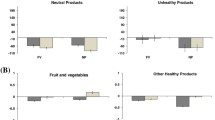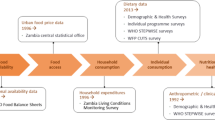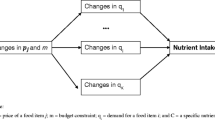Abstract
We examine the effect of nutrient prices and other socio-economic and health factors on the Body Mass Index (BMI) of Canadians using the Canadian Community Health Survey (CCHS). The CCHS data does not include information on nutrition intake, and so the price of fat, carbohydrates and protein are included to capture the effects of diet on BMI. The results indicate that changes in nutrient prices in the model have statistically significant impacts on BMI and the direction of the impacts corresponds to hypotheses from the nutrition literature. However, all estimates are inelastic so that the effect of fat taxes or thin subsidies is small. The results also indicate that education is negatively related and income is positively related to BMI.
Similar content being viewed by others
References
Auld, M. C., & Powell, L. M. (2009). Economics of food energy density and adolescent body weight. Economica, 76, 719–740.
Beatty, T. K. M. (2007). Recovering the shadow value of Nutrients. American Journal of Agricultural Economics, 89(1), 52–62.
Boizot-Szantai, Christine and Fabrice Etile (2005), The food prices/body mass index relationship: Theory and evidence from a sample of French adults, 11th Congress of the European Association of Agricultural Economists, August, 2005
Chou, S.-Y., Grossman, M., & Saffer, H. (2004). An economic analysis of adult obesity: results from the behavioral risk factor surveillance system. Journal of Health Economics, 23(3), 565–578.
Clark, J. S., & Dittrich, O. L. (2010). Alternative fat taxes to control obesity. International Advances in Economic Research, 16, 388–394.
Goldman, D., Lakdawalla, D., & Zheng Y. H. (2009). “Food prices and the dynamics of body weight,” National Bureau of Economic Research Working Paper No. 15096.
Lakdawalla, D. & Philipson, T. (2002). “Technological Change and the Growth of Obesity: A Theoretical and Empirical Examination,” National Bureau of Economic Research
Nichols, B. L. (1994). Atwater and USDA Nutrition Research and Service: A Prologue of the Past Century. Journal of Nutrition, 124(9), 1718–1727.
Raben, A., Agerholm-Larsen, L., Flint, A., Holst, J. J., & Astrup, A. (2003). Meals with similar energy densities but rich in protein, fat, carbohydrate or alcohol have different effects on energy expenditure and substrate metabolism but not on appetite and energy intake. The American Journal of Clinical Nutrition, 77, 91–100.
Statistics Canada (2012a). Body mass index, overweight or obese, self-reported, adult, by age group and sex. Available at: http://www.statcan.gc.ca/tables-tableaux/sum-som/l01/cst01/health81a-eng.htm, Accessed June 2013.
Statistics Canada (2012b). Canadian Community Health Survey – Annual Component (CCHS),” at: http://www23.statcan.gc.ca/imdb/p2SV.pl?Function=getSurvey&SDDS=3226&lang=en&db=imdb&adm=8&dis=2>, Accessed 11 Sept 2012.
Statistics Canada (2012c). “Table 003-0080: Nutrients in the food supply, by source of nutritional equivalent and commodity, annual (milligrams unless otherwise noted),” CANSIM (database).
Statistics Canada (2012d). “Table 203-0021: Survey of household spending (SHS), household spending, Canada, regions and provinces, annual (dollars),” CANSIM (database).
Statistics Canada (2012e). “Table 203-0028: Survey of household spending (SHS), food expenditures, Canada, annual (dollars),” CANSIM (database).
Statistics Canada (2012f). “Table 326-0021: Consumer Price Index (CPI), 2009 basket, annual (2002=100 unless otherwise noted),” CANSIM (database).
Sturm, R., & Datar, A., (2005). “Body mass index in elementary school children, metropolitan area food prices and food outlet density,”. Public Health, 119(12), 1059–1068.
Sturm, R., & Datar, A., (2008). “Food prices and weight gain during elementary school: 5-year update,” Public Health, 122(11), 1140–1143.
World Health Organization (2011). “Obesity and Overweigh,” World Health Organization. <http://www.who.int/mediacentre/factsheets/fs311/en/index.html> (28 March 2011)
Acknowledgment
The authors gratefully acknowledge the support of the Consumer and Market Demand research network
Author information
Authors and Affiliations
Corresponding author
Rights and permissions
About this article
Cite this article
Clark, J.S., Dittrich, O.L., Law, S.M. et al. Nutrient Prices and Other Socio-Economic and Health Determinants of the Body Mass Index of Canadians. Int Adv Econ Res 20, 249–258 (2014). https://doi.org/10.1007/s11294-014-9475-y
Published:
Issue Date:
DOI: https://doi.org/10.1007/s11294-014-9475-y




